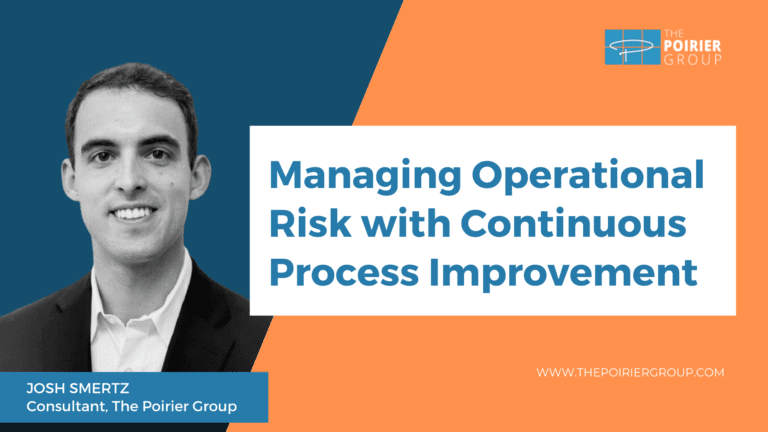
"Leveraging existing technology will not only create cost savings, but it will also enhance the operational and financial risk environment by reducing the number of errors, ensuring proper delegations of authorities, creating process transparency, producing audit trails and enhancing the pool of available data by which to perform data analysis."
I view continuous process improvement and risk management as having a symbiotic relationship. Often there is potential to achieve process improvements while also enhancing operational and financial risk coverage. A mature risk environment provides greater trust in the operational and financial data used as a foundation for process improvements.
One example is the introduction of digital transformation to replace a manual business process. By introducing digital transformation into a business process, you not only receive direct cost savings from process efficiencies, but you also realize a significant reduction in the risks of operational errors and data integrity issues.
Continuous process improvement can also be applied in the creation of a visual measurement system to measure key risk indicators (KRIs). KRIs are used by corporate governance teams as a pulse check on the organization’s evolving exposure to risks and achieving its strategic objectives. They can be used in conjunction with KPIs, or key performance indicators, to offer an early warning sign that the KPI and its associated strategic objectives are at risk of being negatively impacted.
Organizations can leverage technology to semi or fully automate the data collection, analysis reporting and risk mitigation processes, creating the ability to monitor the risk environment trends, real-time and 24/7.
I believe there are many potential impacts. Below are a few of the major ones:
I’m currently working with a consumer products company to address challenges such as reduced orders due to poor data quality, misaligned forecasting to its ERP, lack of KPIs to measure progress and unclear roles and responsibilities. We’re taking a two-pronged approach to address these challenges. The first is optimizing the sales and operations planning process. The second is designing and implementing a transformation management office (TMO).
I’m also active with our ‘Purpose Beyond Profit’ program, where we’re working with the Toronto chapter of an international mentorship organization to significantly increase the number of mentorship pairs served and reduce the wait time mentors and mentees experience during the matching process. Helping this organization make a greater impact in the community and seeing change happen has been an extremely rewarding experience. In recognition of our approach to meeting these objectives, we received an award from the Institute of Industrial and Systems Engineers (IISE) and received second place.
For organizations looking to implement quick wins, I recommend starting with exploring the capabilities of existing technologies and infrastructure to aid in the performance of operational financial business processes. I’ve seen multiple organizations performing manual business processes when they already have the capability to perform the same business processes in a digital environment. Leveraging existing technology will not only create cost savings, but it will also enhance the operational and financial risk environment by reducing the number of errors, ensuring proper delegations of authorities (e.g. through workflows), creating process transparency, producing audit trails and enhancing the pool of available data by which to perform data analysis.
Tell me a little about your career path. What made you get into consulting? (Life experiences, skillset, a mentor etc.)
“I began my consulting career at Ernst and Young, immediately after graduating from the University of Pittsburgh in 2014. It was entirely by chance that I happened to be accepted into a consulting role because at the time I was exploring other career paths as well. Early on in my career, consulting allowed me to get great exposure to Fortune 500 companies in a variety of industries. It accelerated my learning and development at a rapid pace. As I progressed in my career, I began to appreciate working in the consulting world. It was a naturally great outlet for my curiosity and interest in problem-solving and also provided the opportunity to solve a variety of problems across all areas of the business, or clients in a variety of industries. This lent itself nicely to my interest in becoming a well-rounded professional”
What is something you are passionate about outside of your job role?
“Outside of work I enjoy travelling, particularly to places that offer a combination of natural, cultural and historical experiences— such as Spain, Italy, Indonesia, and Chile, just to name a few.
“Whether it’s a new country, state, province or town, I believe there’s something new to learn from anywhere you visit. I enjoy the experience of stepping into a new environment and learning as much as possible about the food, customs and culture of the people in the places that I visit.
“Travelling has helped me develop an open-minded, global and empathetic mindset—characteristics that are extremely valuable in both my professional and personal lives. I’m also really passionate about astronomy and love to find ways to pair astronomy with travel by travelling to world-renowned stargazing destinations. For example, I once travelled to an astronomical hotel, and it’s on my bucket list to visit them all.”
What initially drew you to TPG?
“I was drawn in by the collaborative and family-style community of people. I enjoy working with people who are committed to helping you succeed and grow. I was also drawn in by the focus on serving the community, particularly through the Purpose Beyond Profit program. It’s fulfilling to be part of an organization that recognizes the importance of giving back to the community.
“Additionally, I was looking for a smaller boutique firm where I could make as much of an impact internally as well as externally with our clients. I appreciate the fact that TPG has an interest in continuously improving and encourages its consultants to be a part of that change.”